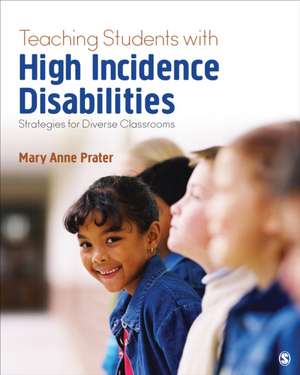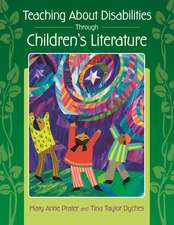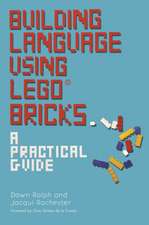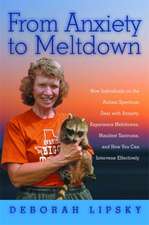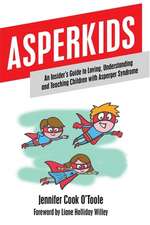Teaching Students With High-Incidence Disabilities: Strategies for Diverse Classrooms
Autor Mary Anne Prateren Limba Engleză Paperback – 10 feb 2017
Preț: 933.11 lei
Preț vechi: 1278.24 lei
-27% Nou
178.55€ • 186.92$ • 147.74£
Carte tipărită la comandă
Livrare economică 05-19 aprilie
Specificații
ISBN-10: 1483390594
Pagini: 680
Dimensiuni: 203 x 254 mm
Greutate: 1.13 kg
Ediția:1
Editura: SAGE Publications
Colecția Sage Publications, Inc
Locul publicării:Thousand Oaks, United States
Cuprins
Acknowledgments
About the Author
About the Contributor
1 Learner Characteristics and Special Education Laws
Definitions and Prevalence Rates
Characteristics that Impact Instruction
Diverse Populations
Key Legislation
Common Core and Standards
The Individualized Education Program (IEP) Process
The IEP Document
Service Delivery
IEP Review and Revision
Aligning Curriculum, Standards, and IEPs
Summary
Review Questions
Activities
2 Educational Collaboration
Models of Working Together
Working to Improve Teacher Performance
Collaboration as a Process
Working With Specific Groups
Collaborating Across Diverse Cultures
Summary
Review Questions
Activities
3 Behavior and Classroom Management and Organization
Behavioral Model
Classroom Management
Physical Classroom
Effective Time Management
Classroom Scheduling
Classroom Rules
Behavior Management Techniques
Implications for Culturally and/or Linguistically Diverse Students
Summary
Review Questions
Activities
4 Integrating Technological Applications
Assistive Technology
Technology Integration Across the Curriculum
Specific Technology Tools
Computer-Assisted Instruction
Online and Blended Learning
Implications for Culturally and/or Linguistically Diverse Students
Summary
Review Questions
Activities
5 Assessment for Instruction
Types and Purposes of Assessment
Standardized Tests
Assessment in the Classroom
Summary
Review Questions
Activities
6 Teacher-Directed Instruction
Teacher Effectiveness Variables
Direct Teaching
Implications for Culturally and/or Linguistically Diverse Students
Summary
Review Questions
Activities
7 Supporting Students in General Education
Importance of General Education Supports
Multitiered Systems of Supports (MTSS)
Models for Supporting Students in General Education
Implications for Culturally and/or Linguistically Diverse Students
Summary
Review Questions
Activities
8 Student-Mediated Instruction
Cooperative Learning
Implementing Cooperative Learning
Cooperative Learning and Teacher-Directed Instruction
Cooperative Learning With Students With Disabilities
Peer Tutoring
Reciprocal Peer Tutoring
Peer-Assisted Learning Strategies (PALS)
Nonreciprocal Peer Tutoring
Implications for Culturally and/or Linguistically Diverse Students
Summary
Review Questions
Activities
9 Strategies for Learning
Strategies for Learning
Attention Strategies
Mnemonic Strategies
Organizing Strategies
Study Strategies
Study Guides
Test-Taking Strategies
Specific Test-Taking Strategies
Notetaking Strategies
Teacher Instruction to Facilitate Notetaking
Guided Notes
Creating Learning Strategies
Implications for Culturally and/or Linguistically Diverse Students
Summary
Review Questions
Activities
10 Strategies for Reading and Writing Instruction
Reading and Writing Disabilities
Reading and Writing Foundations
Reading Instruction
Writing Instruction
Reading/Writing Language Arts Standards
Implications for Culturally and/or Linguistically Diverse Students
Summary
Review Questions
Activities
11 Strategies for Mathematics Instruction
Mathematics Disabilities
Mathematics Content
Number Sense and Numerical Power
Mathematics Standards
Effective Instruction for Students With Math Disabilities
Teacher-Directed Instruction
Specific Mathematics Strategies
Teaching Advanced Mathematics
Math Response to Intervention
Implications for Culturally and/or Linguistically Diverse Students
Summary
Review Questions
Activities
12 Strategy Application in Other Content Areas
Curriculum Design and Unit Development
General Strategies Across Content Areas
Science
Social Studies
Integrative Curriculum
Implications for Culturally and/or Linguistically Diverse Students
Summary
Review Questions
Activities
13 Social and Emotional Learning
Importance of Social and Emotional Learning (SEL)
Promoting Prevention and Early Intervention
Identifying Students With Social and Emotional Concerns
Teaching Social and Emotional Competence
Emotional Regulation
Social Skills
Self-Management
Implications for Culturally and/or Linguistically Diverse Students
Summary
Review Questions
Activities
14 Life Skills and Transition
Transition Services
Learn, Work, Live, and Play
Involving Stakeholders
Implications for Culturally and/or Linguistically Diverse Students and Families
Summary
Review Questions
Activities
Appendixes
Glossary
Index
Descriere
To ensure that all students receive quality instruction, Teaching Students with High-Incidence Disabilities prepares preservice teachers to teach students with learning disabilities, emotional behavioral disorders, intellectual disabilities, attention deficit hyperactivity, and high functioning autism. It also serves as a reference for those who have already received formal preparation in how to teach special needs students. Focusing on research-based instructional strategies, Mary Anne Prater gives explicit instructions and includes models throughout in the form of scripted lesson plans. The book also has a broad emphasis on diversity, with a section in each chapter devoted to exploring how instructional strategies can be modified to accommodate diverse exceptional students. Real-world classrooms are brought into focus using teacher tips, embedded case studies, and technology spotlights to enhance student learning.
